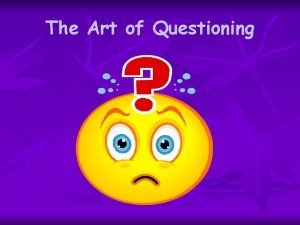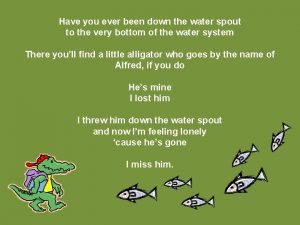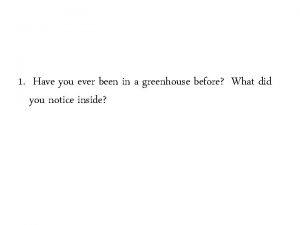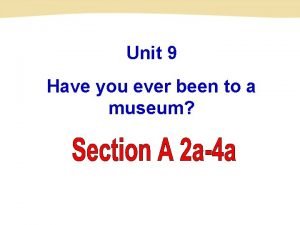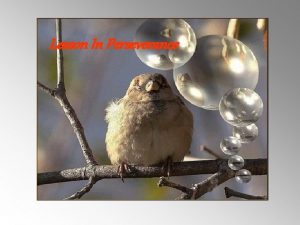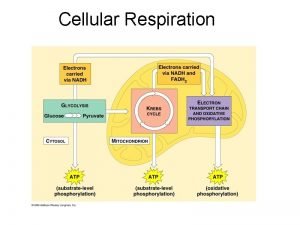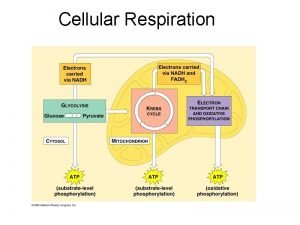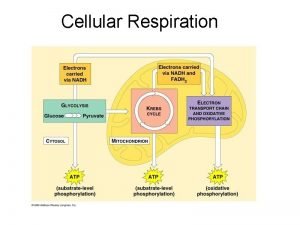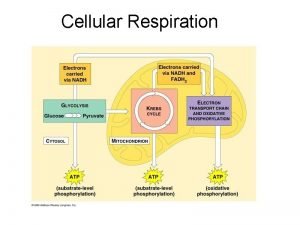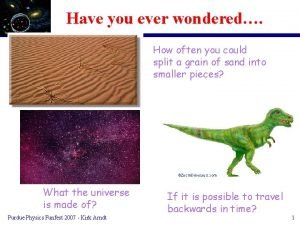Cellular Respiration Cellular Respiration Have you ever wondered


















- Slides: 18

Cellular Respiration

Cellular Respiration Have you ever wondered why exactly you need to breathe? What happens when you stop breathing?

Cellular respiration is the set of the metabolic reactions and processes that take place in the cells of all organisms to convert biochemical energy from carbs into adenosine triphosphate (ATP – cell energy), and then release waste products.

Respiration Formula C 6 H 12 O 6 + 6 O 2 -->6 CO 2 + 6 H 2 O + 36 ATP Look familiar?

The best respiration occurs in the presence of oxygen - called AEROBIC Without oxygen, fermentation (anaerobic respiration) is used, but it’s not as good (We’ll come back to this…)

There are three stages in Aerobic Respiration 1. Glycolysis 2. Kreb's Cycle (aka Citric Acid Cycle) 3. Electron Transport Chain and Oxidative Phosphorylation

Stage One GLYCOLYSIS = "glyco - lysis " is the splitting of a 6 carbon glucose into two 3 -Carbon pyruvates to release a small amount of energy. Can occur without oxygen. - net yield of 2 ATP and 2 NADH per glucose molecule (4 total produced ATP – 2 used ATP = 2 net produced ATP)

Stage 2: Citric Acid/Krebs Cycle a) occurs in the mitochondria; completely breaks down the pyruvates from stage 1 to release all the energy; generates CO 2 waste b) net yield of 2 ATP, 6 NADH and 2 FADH 2, which are all sent to stage 3 c) aerobic process; will occur only with O 2

Stage 3: ETC and Ox Phos: a) series of enzymes on the inner mitochondrial membrane; requires oxygen b) Charged electrons are released from NADH and FADH 2 (from stages 1 and 2) and passed along a series of enzymes, giving up energy which is used to fuel a proton gradient for chemiosmosis c) Makes ATP with ATP Synthetase (just like the ETC in Photosynthesis, just different names and different energy sources)

All three stages = Total net yield of 34 -36 ATP per glucose 6 H 2 O are formed as waste when the electrons unite with O 2* at the end of the electron transport chain. * Note: Oxygen is required for stages 2 and 3. Without it, neither stage will proceed.

Does this picture look familiar? You've seen this before in photosynthesis. Animation of the ETC Mc. Graw Hill Animation

What about no oxygen situations? Anaerobic Respiration, AKA - Fermentation This happens when the Krebs cycle cannot occur due to lack of oxygen; purpose is to regenerate NAD+ so glycolysis can continue (2 ATP is better than none) Two types of fermentation – lactic acid (animals) and alcoholic (yeast/bacteria) Byproducts include lactic acid or alcohol - Note: Lactic Acid in muscle cells causes muscle cramps.

Fermentation is used in making food products and alcohol products.

What are the 3 stages of cellular respiration? 1. 2. 3.

Food for thought 1. What is the purpose of cellular respiration? 2. Where does cellular respiration occur within the cell? 3. What is the waste product of cellular respiration? Would you go to an oxygen bar?

4. Compare Photosynthesis to Respiration a. Where does each occur? b. What are the products of each? c. What compounds are needed to start the processes? d. What is the function of the electron transport chain in each process e. Describe the role of ATPase in both processes.

Self Test 1. In order to produce energy, cells start with glycolysis. If oxygen is NOT present after glycolysis, what process occurs next? a) Electron Transport Chain b) Krebs Cycle c) Fermentation 2. If oxygen IS present after glycolysis, what process occurs next? a) Electron Transport Chain b) Krebs Cycle c)Fermentation 3. A process that does NOT require oxygen is known as what? a) Aerobic b) Anaerobic 4. In glycolysis, glucose is broken into 2 molecules of _________ acid 5. Where does the Kreb's cycle occur? _________ 6. What gas is a waste product produced in the Krebs cycle? ____

7. What enzyme is used in the electron transport chain to create ATP? a. citric acid b. pyruvate c. ATPase 8. Where does glycolyis occur? a. cytoplasm b. mitochondria c. chloroplast 9. Which process produces the largest amount of ATP? a. fermentation b. Krebs Cycle c. ETC 10. The oxygen required by cellular respiration is reduced and becomes part of which molecule? a. ATP b. CO 2 c. H 20
 Have you ever wondered
Have you ever wondered Art of questioning
Art of questioning Have you ever wondered why some people
Have you ever wondered why some people For many years people have wondered
For many years people have wondered Ever ancient ever new
Ever ancient ever new Ever ancient ever new
Ever ancient ever new Have you ever looked
Have you ever looked Ever tried ever failed no matter
Ever tried ever failed no matter Have you ever done anything dangerous
Have you ever done anything dangerous Shoplifting statistics
Shoplifting statistics Have you ever read a book
Have you ever read a book Have you ever experienced culture shock
Have you ever experienced culture shock Have you ever climbed a mountain
Have you ever climbed a mountain Have you ever been to the water spout
Have you ever been to the water spout Have you ever ridden a camel?
Have you ever ridden a camel? Have you ever climbed a mountain?
Have you ever climbed a mountain? Have you ever seen a “greenhouse”?
Have you ever seen a “greenhouse”? Have you seen this area before?
Have you seen this area before? Have you ever watched people
Have you ever watched people

